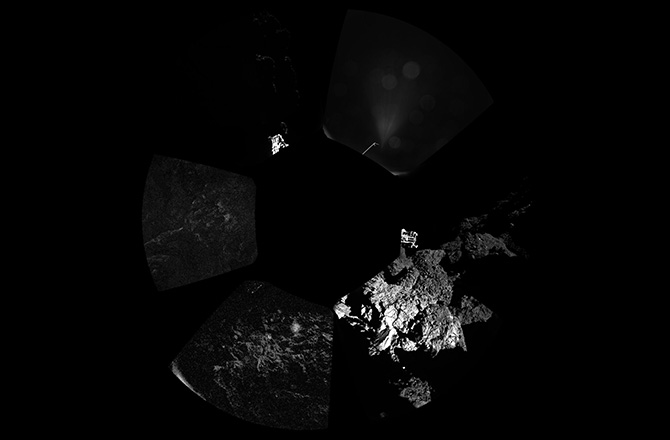Philae Rises! What's Next for Rosetta's Comet Lander?

Perched on the surface of a comet, the revived Philae lander should soon be able to resume — and possibly expand — an unprecedented examination of organic material believed to date back to the beginning of the solar system.
Released by the Rosetta mothership, Philae floated down to the surface of Comet 67P/Churyumov-Gerasimenko on Nov 12, but its anchoring harpoons failed and the 220-pound probe shot back into space. It landed a second time, bounced and finally came to rest about a half-mile away with two of its three legs on the ground and wedged next to a cliff wall.
Top 10 Space Stories of 2014: Readers'Choice
Nevertheless, Philae ran through a 64-hour, pre-programmed series of experiments before its batteries died. The lander was supposed to set down in an area nearly always illuminated by the sun to recharge its batteries. Instead it ended up in shadow and fell silent. [See more comet photos from Rosetta and Philae]
Spacecraft controllers continued to use the orbiting Rosetta spacecraft to hunt for a signal from Philae while they waited for the comet to move closer to the sun, hoping the lander would recharge itself.
Over the weekend, Philae finally phoned home — twice — rekindling scientists' hopes that the mission could resume.
First, though, flight controllers need to figure out when Philae will be in regular position to communicate with Rosetta, which is used to relay the lander's signals to Earth.
Get the Space.com Newsletter
Breaking space news, the latest updates on rocket launches, skywatching events and more!
PHOTOS: Rosetta's Landing: When Philae Grabbed a Comet
"It's of utmost importance to see if we can get a stable communications pattern between the two machines," Rosetta deputy flight director Elsa Montagnon, with the European Space Agency, told reporters during a webcast press conference at the Paris Air Show.
"If we can do that, then we can do the next step and resume the scientific operation of Philae," she said.
Managers plan to reposition Rosetta a bit closer to the comet, which is becoming more active as it races toward the sun. The closest approach will be on Aug. 13. The comet is in a 6.5-year orbit around the sun that comes as close as between Earth and Mars and as far as beyond Jupiter.
Moving Rosetta is a bit risky because gas, dust and ice jetting from the comet can confuse the spacecraft's navigational cameras.
ANALYSIS: Philae's Batteries Have Drained, Comet Lander Sleeps
"Imagine taking your car through a snowstorm — you don't see very much. It's not very safe," Montagnon said.
However, the potential for more science from Philae, particularly as the comet undergoes dramatic changes from heating, makes the risk worthwhile, project managers said.
This article was provided by Discovery News.
Join our Space Forums to keep talking space on the latest missions, night sky and more! And if you have a news tip, correction or comment, let us know at: community@space.com.

Irene Klotz is a founding member and long-time contributor to Space.com. She concurrently spent 25 years as a wire service reporter and freelance writer, specializing in space exploration, planetary science, astronomy and the search for life beyond Earth. A graduate of Northwestern University, Irene currently serves as Space Editor for Aviation Week & Space Technology.









